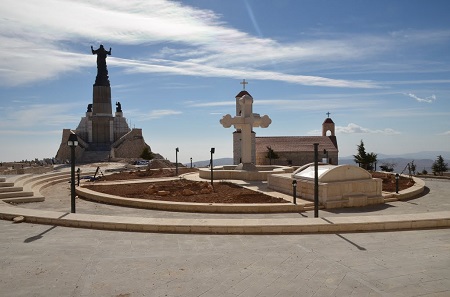Strong will, relentless efforts and generosity, gave life back to a ruined convent
The Cherubim Monastery stands like an eagle at the top of the Qalamoun chain of mountains, 2000m above sea level, 37km from Damascus and 7km from Saidnaya. From its balconies you can see the Ghouta of Damascus and the mountains of southern Syria, the town of Dmeir to the east and Ba’albak and the Beka’a Valley of Lebanon to the west.
The monastery consists of a church, a shrine, a lodge for the monks, a guest house, a center for the youth and, until two years ago, an orphanage.
The monastery was first built in the third century AD on the site of an Aramaic, then Roman pagan temple, but it was destroyed in the sixteenth century. History books mention it as Deir Mar Sherpeen. It was a big building built of white stones with a large garden and a water spring. It used to have a lot of balconies and windows from where visitors of the monastery used to enjoy the views of the green orchards of Damascus.
Many monks and historians visited the church and the remains of the monastery between the 18th and middle of the twentieth century and registered their notes which all said that it was worship place of the Catholics of Syria. In 1986 a road was opened to the site and works began to restore the monastery. In 2001 the great mission was fulfilled.
The monastery was rebuilt and furnished to receive his holiness Pope John Paul II in his planned visit to Syria on May 5th. 2001. For health reasons the Holy Pontiff stayed in the Papal Embassy in Damascus.
house with its five floors, and pyramid shape with linked semicircular arches, where visitors can stay for a day or two. The first floor is built from large stones that belong to the Roman and Byzantine era .To the east of the main building there is a smaller building with three floors of the same design, sacrificed for the seat of the archbishop and his aides. In the corridors of the second floor there are many marble boards inscribed with the names of the donors who participated in rebuilding this great edifice.
In 1999 an orphanage was built behind the monastery, but the requirements of accommodating 50 orphans were heavier than the monastery could bear, so they were moved to the orphanage of the Monastery of Saidnaya. Now the first floor of the orphanage is used by visitors of the place, while the upper floor is used by the Orthodox Youth.
The Church of the Cherubim was originally built between the fourth and the seventh centuries AD, mostly at the same time the Church of Saidnaya was built, that is the fourth century.
It is built from large stones with a long colonnaded arcade supported by 3 huge Roman columns. The church had a brick gable roof with a tower in the right side that holds the bell. The interior is moderately small with few seats, but valuable icons cover the walls and very rich old style chandeliers dangle from the ceiling. The church was renovated in 1982.
At a high rock just behind the church, stands the shrine of Mary the Virgin with a large white cross on top, and the tower of the bell to the right.
Around the monastery there are many ancient grottos which were dwelled by pre-history man who lived in the Qalamoun Mountains. One of these grottos to the west of the monastery is dug in solid rocks at the top of a height and is called the Court . It is thought that in the early days of Christianity it served as a sanctuary for the priests to hear confessions and do their processions.
Linguistically Cherubim is derived from a Canaanite word kirabim winged angels, or from Assyrian kirubuwhich means heavenly spirits.
The word cherubim is used several times in the Old Testament and once in the New Testament with the same meaning.
Haifaa Mafalani

